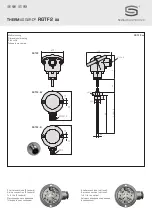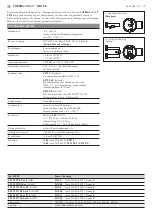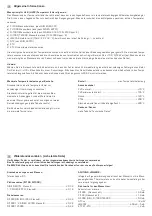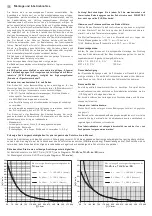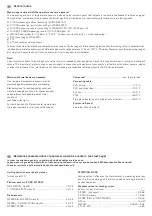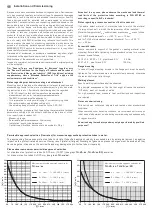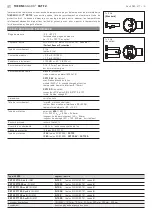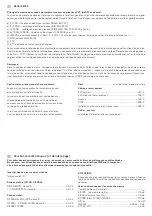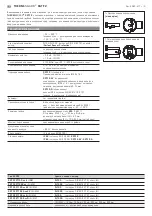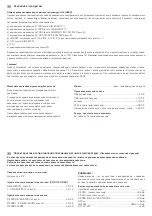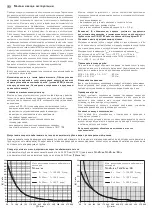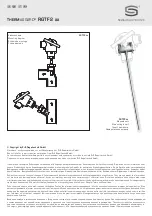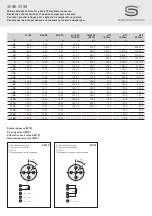
Measuring principle of HVAC temperature sensors in general:
The measuring principle of temperature sensors is based on an internal sensor that outputs a temperature-dependent resistance signal.
The type of the internal sensor determines the output signal. The following active ⁄ passive temperature sensors are distinguished:
a) Pt 100 measuring resistor (according to DIN EN 60 751)
b) Pt 1000 measuring resistor (according to DIN EN 60751)
c) Ni 1000 measuring resistor (according to DIN EN 43 760, TCR = 6180 ppm ⁄ K)
d) Ni 1000_TK 5000 measuring resistor (TCR = 5000 ppm ⁄ K)
e) LM235Z, semiconductor IC (10 mV ⁄ K, 2.73 V ⁄ °C). Ensure correct po ⁄– when connecting!
f) NTC (according to DIN 44070)
g) PTC
h) KTY silicon temperature sensors
The most important resistance characteristics are shown on the last page of these operating instructions. According to their characteristics,
individual temperature sensors exhibit different slopes in the range between 0 °C and +100 °C (TK value). Maximum-possible measuring ranges
also vary from sensor to sensor (for some examples to this see under technical data).
Note!
Select immersion depth for built-in sensors so that the error caused by heat dissipation stays within the admissible error margins. A standard
value is: 10 x diameter of protection tube + sensor length. In connection with enclosure-type sensors, particularly with outdoor sensors, please
consider the influence of thermal radiation. For that purpose, a sunshade and radiation protector SS-02 can be attached.
Component ................................................................ max. thermal load
Connecting cable
PVC, normal ....................................................................................+70 °C
PVC, heat-stabilized.................................................................... +105 °C
Silicone ......................................................................................... +180 °C
PTFE ............................................................................................. +200 °C
Fibreglass insulation with stainless steel texture ............... +400 °C
Enclosure ⁄ Sensor
see table „Technical Data“
Maximum thermal load on components:
On principle, all temperature sensors shall be
protected against unacceptable overheating!
Standard values for individual components and
materials selected are shown for operation under
neutral atmos phere and otherwise normal
conditions
(see table to the right).
For combinations of different insulating materials,
the lowest temperature limit shall always apply.
G
General notes
G
Resistance characteristics of passive temperature sensors (see last page)
In order to avoid damages ⁄ errors, preferably shielded cables are to be used.
Laying measuring cables parallel with current-carrying cables must in any case be avoided. EMC directives shall be observed!
These instruments must be installed by authorised specialists only!
ATTENTION, NOTE !
Testing current influences the thermometer‘s measuring accuracy
due to intrinsic heating and therefore, should never be greater than
as specified below:
Standard values for testing current:
Sensor current, maximum ................................................................. I
max.
Pt1000 (thin-layer) .................................................................. < 0,6 mA
Pt100 (thin-layer) ....................................................................... < 1,0 mA
Ni1000 (DIN), Ni1000 TK5000 ............................................. < 0,3 mA
NTC xx ............................................................................................ < 2 mW
LM235Z ............................................................................. 400 µ A … 5 mA
KTY 81 - 210 .................................................................................... < 2 mA
Limiting deviation according to classes:
Tolerances at 0 °C:
Platinum sensors (Pt100, Pt1000):
DIN EN 60751, class B ................................................................± 0.3 K
1 ⁄ 3 DIN EN 60751, class B ........................................................± 0.1 K
Nickel sensors:
NI1000 DIN EN 43760, class B .................................................± 0.4 K
NI1000 1 ⁄ 2 DIN EN 43760, class B.........................................± 0.2 K
NI1000 TK5000 ...........................................................................± 0.4 K


